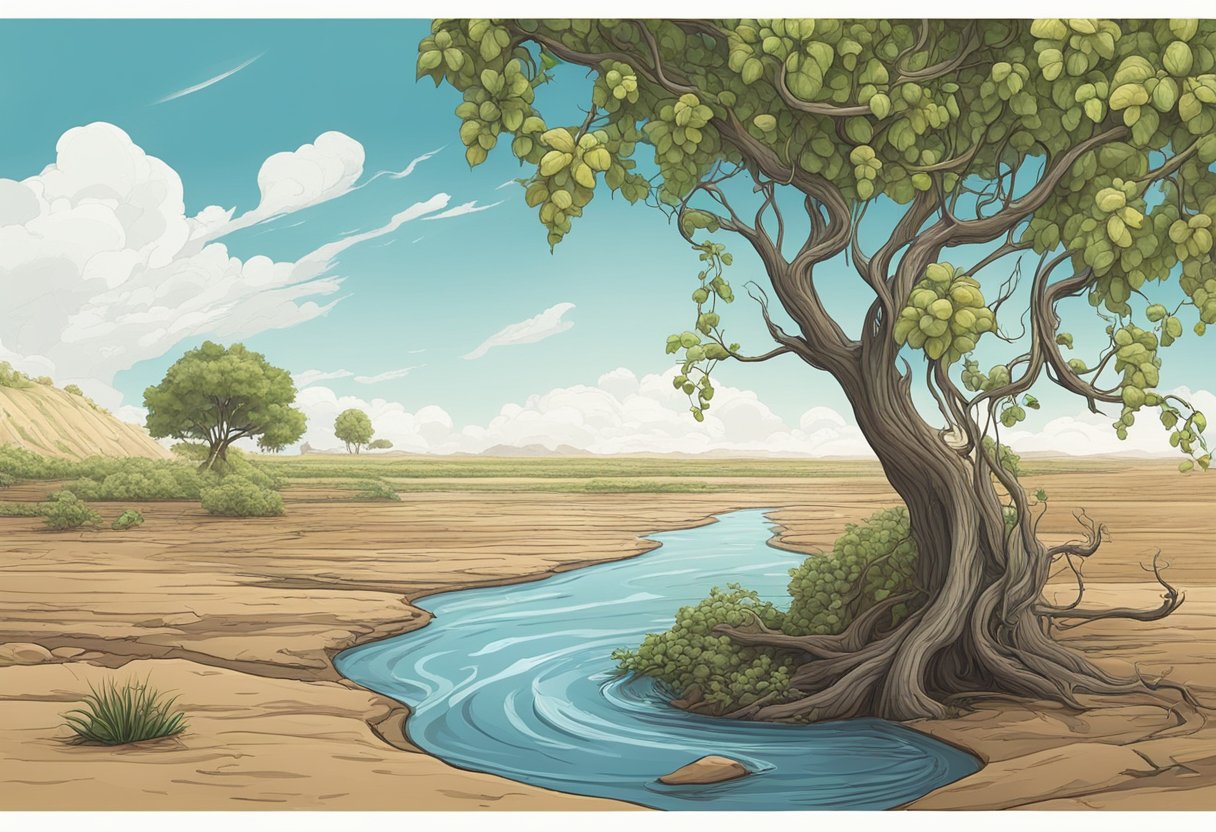Climate change poses significant challenges and changes for viticulture—the cultivation of grapevines. The intricate balance required to produce high-quality grapes for winemaking is sensitive to temperature, precipitation, and extreme weather events, all of which are impacted by the changing climate.

The influence of climate on wine production cannot be overstated. Grapes require specific conditions to achieve the optimal balance of sugar, acidity, and flavor compounds.
As the planet warms, traditional wine-growing regions may experience altered growing seasons, while new regions may emerge.
Your role in recognizing these shifts and adapting viticulture practices will be vital in safeguarding the future of wine production.
Sustainable practices, such as selecting heat-resistant grape varieties or modifying vineyard management techniques, are becoming essential tools to offset the impact of a warming world on viticulture.
Key Takeaways
- Climate change is significantly altering viticulture, necessitating new adaptation strategies.
- Wine production is deeply influenced by climate, with global warming shifting growing regions and wine profiles.
- Sustainability in viticultural practices is critical to respond to and mitigate the effects of climate change.
The Effects of Climate Change on Viticulture
Your understanding of wine begins in the vineyard, and with climate change, the very foundation of viticulture is shifting. Rising temperatures, changing weather patterns, and the physiological stress on grapevines are rewriting the rules of grape growing.
Global Warming and Grape Varieties
Global warming is reshaping the landscape of viticulture by altering the range in which different grape varieties thrive. The typically preferred Vitis vinifera may face challenges, as a temperature rise of approximately 1.0-3.0°C by 2050 could demand new strategies for keeping the vines healthy and productive.
Notable shifts include a move toward cooler coastal and northern regions to maintain the delicate balance required for premium wine production, evident from insights found here.
Heat accumulation in a growing season influences grape maturity, with certain varieties requiring specific conditions to achieve their ideal sugar and phenolic content.
Warmer temperatures could hasten fruit ripening, potentially leading to imbalances in acidity and tannins, which are crucial for wine quality.
Changing Weather Patterns and Viticulture
Changing weather patterns mean more than just warmer days; they represent increased unpredictability and extreme events that can complicate vineyard management.
For instance, variations in precipitation—ranging from a decrease of 40% up to an increase of 40%—pose risks for adequate water supply and water stress for vines, as detailed in research here.
Droughts can severely limit water available for irrigation, whereas excessive rainfall may lead to fungal diseases. Both extremes are detrimental to grape growing.
Grapevine Physiology and Climate Factors
Grapevines respond to climate factors in various ways. Temperature can affect the rate of photosynthesis and phenolic development, while sunlight exposure is crucial for fruit set and quality.
Increased temperatures can elevate the transpiration rate of the vines, leading to higher water demands.
When you manage a vineyard, consider the interaction between grapevine physiology and climate factors.
Warmer nights accelerate respiration, which may deplete the vines of the carbohydrates they need to thrive. Additionally, water use efficiency becomes paramount as grapes face water stress from heat and potential drought conditions.
Viticultural Practices and Sustainability
Sustainable viticulture emphasizes environmental protection, resource conservation, and economic viability, ensuring the welfare of vineyards for generations. These practices are designed to meet current needs while safeguarding future potential.
Sustainable Development in Vineyards
Your approach to sustainable development in vineyards largely determines the long-term success of wine production.
By selecting durable plant material and diverse grapevine rootstocks, you strengthen the resilience of your vineyard against disease and stress.
Conservation techniques also include maintaining soil health through cover cropping and reduced tillage, which bolster the grapevines’ ability to withstand extreme weather.
Water Management and Drought Adaptation
In the face of drought conditions, effective water management becomes crucial.
Strategic water resources planning, including rainwater capture and drip irrigation, ensures water is available when vines need it most.
These tactics mitigate water deficits and enhance the grapevine response to environmental stressors.
To further aid in drought adaptation, some vineyards explore biodynamic wine practices that align with natural rhythms and cycles to sustain plant health.
Innovations in Viticulture for Climate Resilience
To maintain sustainability, innovative management practices are vital.
Advances such as temperature-controlled fermentation can improve wine quality and reduce resource waste.
Embracing new technologies for monitoring vine stress and precision viticulture tools can lead to more informed decisions, helping your vineyard adapt to climatic challenges.
Meanwhile, ongoing research furthers our understanding of cultivation methods that bolster resilience and adaptation efforts.
Wine Production and Climate Influence

Climate variations directly affect your vineyard’s yield and the quality of the wine produced. Changes in temperature, precipitation patterns, and extreme weather events influence the delicate balance of growing grapes and producing wine.
Impact on Wine Quality and Composition
Grapes are highly sensitive to their environment, and their characteristics critically shape wine quality.
As temperatures rise, the sugar content in grapes increases, leading to higher alcohol levels in wine.
Conversely, the acid levels may drop, potentially diminishing the beverage’s freshness and balance.
The phenolic composition of grapes, which contributes to the wine’s flavor profile and aging potential, is also altered by shifting climate conditions.
Vineyards in traditionally cooler regions such as the Northern Hemisphere, including parts of California and the Douro Valley, face the challenge of maintaining the classic profiles of their wines while adapting to these changes.
Ripening Dynamics and Harvest Adjustments
Rising temperatures can lead to a condensed growing season, causing grapes to ripen more quickly.
This requires your harvests to be rescheduled to preserve the grape composition necessary for high-quality winemaking.
Adapting to earlier fruit maturation involves significant shifts in labor and vinification processes.
Vineyard managers must now be vigilant, ready to adjust the timing of their harvest to secure the ideal balance of sugar, acid, and phenolic compounds that define a wine’s character.
Regional Challenges and Innovations
Each wine-producing region faces unique challenges from climate change.
The Mediterranean Basin is experiencing heightened water stress, pushing viticulturists to implement innovative water management strategies.
To maintain wine economics and sustainability, new grape varieties better suited to changing conditions are being considered.
Some regions have begun exploring higher altitude sites or embracing different grape varietals to combat the changing climate.
These shifts may eventually play a role in the evolution of classifications and appellations within the industry, similar to the French AOC system, affecting not only the wine’s environmental responses but its legal and cultural identity as well.
The Science behind Grapes and Climate

Grapes are intricately connected to their growing environment, with climate playing a pivotal role in vine development and fruit quality.
Phenology and Climate Change
Phenology refers to the timing of vine growth stages, from bud break to harvest.
Climate change has led to earlier phenological stages in grapevines. Warmer temperatures often induce earlier flowering and fruit set, potentially affecting the harvest time and grape quality.
Shifts in climate may necessitate changes in cultural practices such as vineyard management to maintain the synchrony of vine development with the optimal climate conditions.
Biochemistry of Grapes under Climatic Stress
Under various climatic stresses, the biochemistry of grapes undergoes significant changes.
Elevated temperatures can increase sugar concentrations, which may alter the balance of acidity in the grapes.
This imbalance could lead to wines with lower acid profiles, impacting their freshness and shelf-life.
Additionally, climatic factors influence the synthesis of anthocyanins and aroma compounds, which are critically important for the color and aromatic quality of wine.
Adaptation Mechanisms of Grapevines
Grapevines possess a range of adaptation mechanisms to cope with climatic stress.
Grapevine rootstocks, which provide the foundation for the grape-producing scion, can offer traits like drought resistance or temperature tolerance through rootstock control.
By selecting and cultivating rootstocks suited to the changing climate, vine growers can augment the vine’s resilience and sustain grape quality.
Adaptation also includes altering cultural practices—such as modifying canopy management or irrigation techniques—to shield the vines from extreme conditions.
The Global Perspective on Viticulture and Climate

Understanding how global climate change is reshaping viticulture is crucial for both consumers and producers. You’ll see the industry’s nimble adaptations, future trends, and evolving market realities as we chart a course through these transformative times.
Climate Change Adaptation in Wine Regions
The impacts of climate change on traditional wine regions are undeniable.
In Burgundy, renowned for its quality wines, vintners are altering grape varieties and changing harvest times to combat earlier blooming.
Similarly, England, once considered too cool for vineyards, is experiencing a burgeoning wine industry thanks to warmer temperatures.
Vineyard managers are increasingly adopting climate change adaptation strategies, such as investing in water management systems to mitigate the risk of droughts in areas like Chile and Argentina.
Future Projections for Wine Industries
Looking ahead, the Northern Hemisphere is projected to experience climate shifts. These shifts will challenge established winegrowing regions while also presenting opportunities for new areas.
As the wine industry braces for the effects of global warming, analyses suggest that regions even farther north may become viticulturally viable. With this shift, established producers may face heightened risk.
Meanwhile, areas like southern England may flourish, creating new, premium wine markets.
Economics and Market Dynamics
Wine economics are tightly coupled with climate responses. Producers must be agile in aligning their portfolios with changing demands.
Wines from cooler climates may become scarcer, which could see price increases. Meanwhile, new regions might emerge as value-driven players in the market.
Yield fluctuations due to climate change will also play a pivotal role. Smaller harvests can spike prices and affect overall supply.
For winegrapes, these variations mean not just quantifiable changes in economics, but also shifts in global market dynamics.

